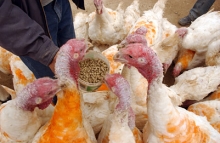# 3677
The discovery of novel H1N1 influenza in Turkeys this past week in Chile has raised concerns that poultry may become another possible avenue for reassortment of the pandemic virus with other flu strains.
Reassortment is the mechanism where two different flu viruses infect the same cell simultaneously, and swap genetic material, producing a new, hybrid virus.
The pandemic virus wending its way around the globe is a reassortment of human, swine and avian flu viruses, and previous pandemics have been launched by similarly derived mutations.
In recent months we’ve seen herds of pigs in Argentina, Canada, and now Australia that have picked up the virus, presumably from infected humans.
We worry most about pigs because they are uniquely susceptible to human, swine, and bird flu strains – making them a likely `mixing vessel’ for influenza’s.
But reassortments can occur in any host; humans, swine, birds . . . any host capable of being infected by influenza viruses.
The danger here isn’t that pigs, or turkeys will get and transmit the novel H1N1 virus to people – there is already plenty of that virus floating around the human population - it’s that they could enable a reassortment of the virus to occur.
While this is a theoretical concern, no one knows how likely it is to actually happen. We know it does happen, but a reassortment that results in a biologically `fit’, and easily transmitted virus would seem to be a fairly rare event.
Else we’d be hip deep in new viruses all the time.
Today, from the UN’s Food and Agriculture Organization (FAO), we get this report on concerns over this reassortment possibility .
H1N1 flu in turkeys may spread
27-08-2009
Poultry connection strengthens global H1N1 pandemic
H1N1 virus confirmed in turkeys at Chilean farms.
27 August 2009, Rome - The detection of an H1N1 virus in turkeys in Chile raises concern that poultry farms elsewhere in the world could also become infected with the pandemic flu virus currently circulating in humans, FAO said today.
Chilean authorities reported on 20 August that the pandemic H1N1/2009 virus was present in turkeys in two farms near the seaport of Valparaiso, Chile. The flu strain found in the poultry flocks is identical to the H1N1/2009 pandemic strain currently circulating among human populations around the world.
No threat to humans
However, the discovery of the virus in turkeys does not pose any immediate threat to human health and turkey meat can still be sold commercially following veterinary inspection and hygienic processing.
“The reaction of the Chilean authorities to the discovery of H1N1 in turkeys — namely prompt reporting to international organizations, establishing a temporary quarantine, and the decision to allow infected birds to recover rather than culling them — is scientifically sound,” said FAO’s interim Chief Veterinary Officer, Juan Lubroth.
“Once the sick birds have recovered, safe production and processing can continue. They do not pose a threat to the food chain,” said Lubroth.
Disease monitoring
The current H1N1 virus strain is a mixture of human, pig and bird genes and has proved to be very contagious but no more deadly than common seasonal flu viruses. However, it could theoretically become more dangerous if it adds virulence by combining with H5N1, commonly known as avian flu, which is far more deadly but harder to pass along among humans.
“Chile does not have H5N1 flu. In South-East Asia where there is a lot of the virus circulating in poultry, the introduction of H1N1 in these populations would be of a greater concern,” said Lubroth.
This is one reason why FAO encourages improved monitoring of health among animals and ensuring that hygienic and good farming practice guidelines are followed, including protecting farm workers if animals are sick and not allowing sick workers near animals.
Related Post:
Widget by [ Iptek-4u ]

